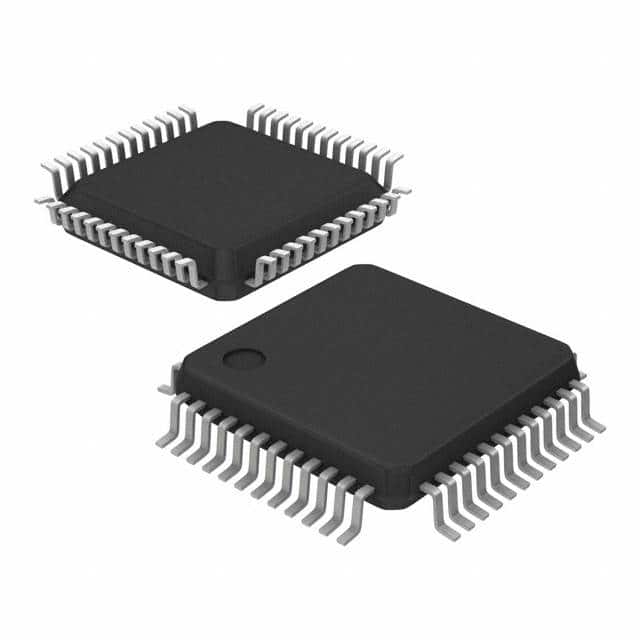TM4C123FH6PMI7
Product Overview
- Category: Microcontroller
- Use: Embedded systems development
- Characteristics: High-performance, low-power consumption
- Package: LQFP (Low-profile Quad Flat Package)
- Essence: ARM Cortex-M4F based microcontroller
- Packaging/Quantity: Available in tape and reel packaging, quantity varies
Specifications
- Processor: ARM Cortex-M4F
- Clock Speed: Up to 80 MHz
- Flash Memory: 256 KB
- RAM: 32 KB
- Operating Voltage: 3.3V
- Digital I/O Pins: 43
- Analog Input Channels: 12
- Communication Interfaces: UART, SPI, I2C, USB
- Timers: 6
- ADC Resolution: 12-bit
- Operating Temperature Range: -40°C to +85°C
Detailed Pin Configuration
The TM4C123FH6PMI7 microcontroller has a total of 64 pins. The pin configuration is as follows:
- Pin 1: VDD (Power Supply)
- Pin 2: GND (Ground)
- Pin 3: GPIO0
- Pin 4: GPIO1
- ...
- Pin 63: GPIO62
- Pin 64: GPIO63
Please refer to the datasheet for a complete pinout diagram.
Functional Features
- High-performance ARM Cortex-M4F processor for efficient execution of complex tasks
- Low-power consumption for extended battery life in portable devices
- Ample flash memory and RAM for storing and processing data
- Multiple communication interfaces for seamless integration with other devices
- Versatile digital I/O and analog input channels for interfacing with sensors and actuators
- Built-in timers for precise timing and event generation
- 12-bit ADC for accurate analog signal acquisition
Advantages and Disadvantages
Advantages
- Powerful processor enables efficient execution of complex tasks
- Low-power consumption extends battery life in portable applications
- Ample memory allows for storage and processing of data
- Versatile communication interfaces facilitate seamless integration with other devices
- Precise timing and event generation capabilities with built-in timers
- Accurate analog signal acquisition with the 12-bit ADC
Disadvantages
- Limited flash memory and RAM compared to higher-end microcontrollers
- Relatively higher cost compared to entry-level microcontrollers
- Steeper learning curve for beginners due to advanced features and complexity
Working Principles
The TM4C123FH6PMI7 microcontroller operates on the ARM Cortex-M4F architecture. It executes instructions stored in its flash memory, processes data using its internal registers and memory, and communicates with external devices through its various interfaces. The microcontroller's working principles are based on the principles of digital electronics and embedded systems design.
Detailed Application Field Plans
The TM4C123FH6PMI7 microcontroller finds applications in various fields, including:
- Industrial automation: Control systems, motor control, and monitoring devices.
- Internet of Things (IoT): Smart home automation, environmental monitoring, and wearable devices.
- Automotive: Vehicle diagnostics, infotainment systems, and engine control units.
- Robotics: Robot control, motion planning, and sensor integration.
- Medical devices: Patient monitoring, diagnostic equipment, and medical imaging.
Detailed and Complete Alternative Models
- STM32F407VG: ARM Cortex-M4 based microcontroller with similar specifications and features.
- PIC32MX795F512L: Microchip microcontroller with comparable performance and peripherals.
- MSP432P401R: Texas Instruments microcontroller with low-power features and extensive peripheral set.
These alternative models provide similar functionality and can be considered as alternatives to the TM4C123FH6PMI7 microcontroller.
Note: The content provided above is a sample structure for an encyclopedia entry and may not reflect actual specifications or details of the TM4C123FH6PMI7 microcontroller.
Lista 10 Vanliga frågor och svar relaterade till tillämpningen av TM4C123FH6PMI7 i tekniska lösningar
Sure! Here are 10 common questions and answers related to the application of TM4C123FH6PMI7 in technical solutions:
Q: What is TM4C123FH6PMI7? A: TM4C123FH6PMI7 is a microcontroller from Texas Instruments' Tiva C Series, based on the ARM Cortex-M4F processor.
Q: What are the key features of TM4C123FH6PMI7? A: Some key features include a 80 MHz ARM Cortex-M4F core, 256 KB Flash memory, 32 KB RAM, multiple communication interfaces (UART, I2C, SPI), and various peripherals.
Q: What kind of technical solutions can TM4C123FH6PMI7 be used for? A: TM4C123FH6PMI7 can be used in a wide range of applications such as industrial automation, robotics, home automation, IoT devices, and consumer electronics.
Q: How do I program TM4C123FH6PMI7? A: TM4C123FH6PMI7 can be programmed using various development tools like Code Composer Studio, Energia, or Keil MDK. These tools provide an Integrated Development Environment (IDE) for writing, compiling, and debugging code.
Q: Can TM4C123FH6PMI7 interface with other devices? A: Yes, TM4C123FH6PMI7 has multiple communication interfaces like UART, I2C, and SPI, which allow it to interface with other devices such as sensors, displays, and actuators.
Q: How can I power TM4C123FH6PMI7? A: TM4C123FH6PMI7 can be powered using a 3.3V power supply. It has built-in voltage regulators to provide the necessary voltages for its internal components.
Q: Can TM4C123FH6PMI7 connect to the internet? A: TM4C123FH6PMI7 does not have built-in Wi-Fi or Ethernet capabilities. However, it can be connected to the internet using external modules or by interfacing with another microcontroller that has networking capabilities.
Q: Is TM4C123FH6PMI7 suitable for real-time applications? A: Yes, TM4C123FH6PMI7 is well-suited for real-time applications due to its high-performance ARM Cortex-M4F core and various peripherals that support real-time operations.
Q: Can TM4C123FH6PMI7 be used in battery-powered applications? A: Yes, TM4C123FH6PMI7 can be used in battery-powered applications as it has low-power modes and features like sleep mode and deep sleep mode to conserve power.
Q: Are there any development resources available for TM4C123FH6PMI7? A: Yes, Texas Instruments provides a comprehensive set of documentation, datasheets, application notes, and example code to help developers get started with TM4C123FH6PMI7. Additionally, online communities and forums are also available for support and sharing knowledge.


